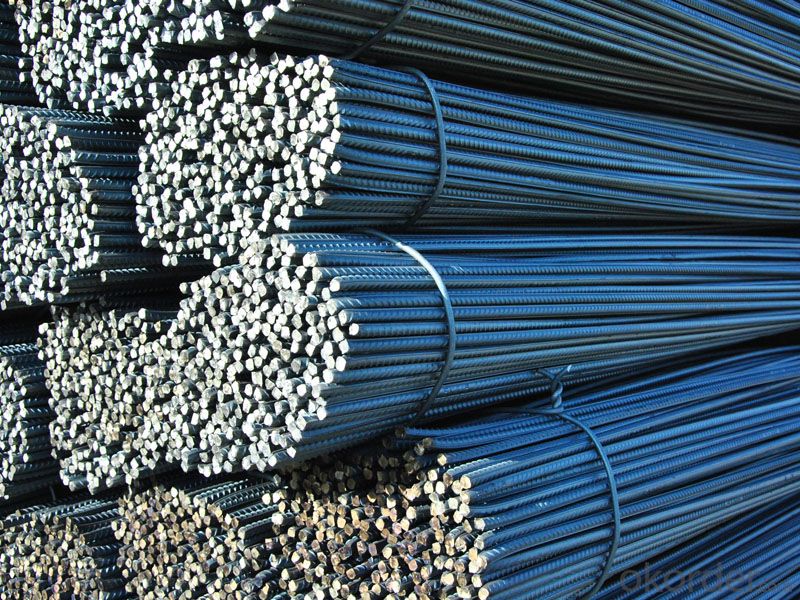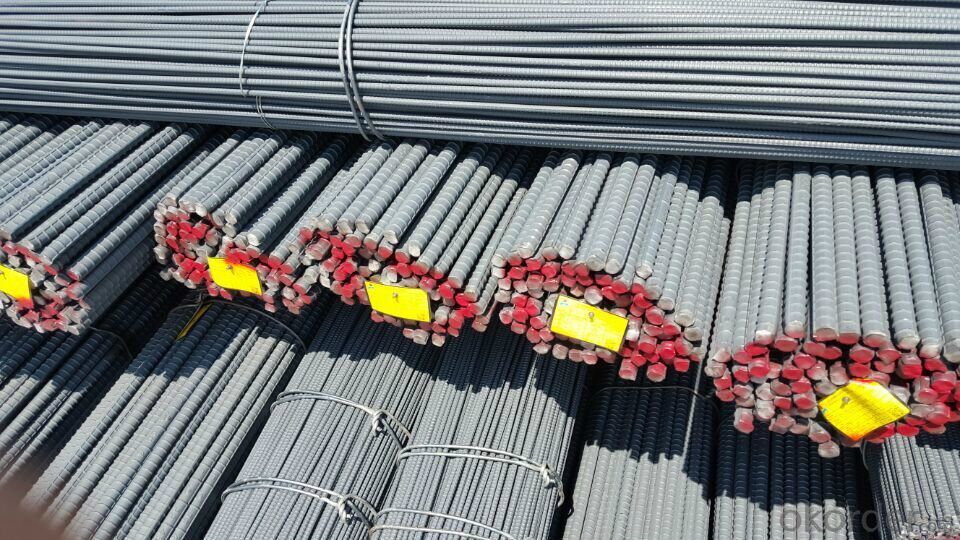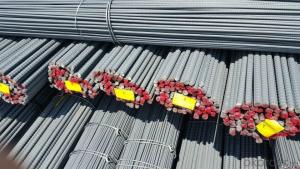Reinforcing Deformed Steel Bars in Grade HRB400 with Best Quality
- Loading Port:
- Tianjin
- Payment Terms:
- TT OR LC
- Min Order Qty:
- 25 m.t.
- Supply Capability:
- 20000 m.t./month
OKorder Service Pledge
OKorder Financial Service
You Might Also Like
Item specifice
OKorder is offering high quality Hot Rolled Rebars at great prices with worldwide shipping. Our supplier is a world-class manufacturer of steel, with our products utilized the world over. OKorder annually supplies products to Africa, North American and Asian markets. We provide quotations within 24 hours of receiving an inquiry and guarantee competitive prices.
Product Applications:
Deformed bar is widely used in buildings, bridges, roads and other engineering construction. Big to highways, railways, bridges, culverts, tunnels, public facilities such as flood control, dam, small to housing construction, beam, column, wall and the foundation of the plate, deformed bar is an integral structure material. With the development of world economy and the vigorous development of infrastructure construction, real estate, the demand for deformed bar will be larger and larger.
Product Advantages:
OKorder's Hot Rolled Rebars are durable, strong, and resist corrosion.
Main Product Features:
· Premium quality
· Prompt delivery & seaworthy packing (30 days after receiving deposit)
· Corrosion resistance
· Can be recycled and reused
· Mill test certification
· Professional Service
· Competitive pricing
Product Specifications:
Manufacture: Hot rolled
Grade: HRB400 – HRB500
Certificates: ISO, SGS, BV, CIQ
Length: 6m – 12m, as per customer request
Packaging: Export packing, nude packing, bundled
Grade | Technical data of the original chemical composition (%) | ||||||
C | Mn | Si | S | P | V | ||
HRB400 | ≤0.25 | ≤1.60 | ≤0.80 | ≤0.045 | ≤0.045 | 0.04-0.12 | |
Physical capability | |||||||
Yield Strength (N/cm²) | Tensile Strength (N/cm²) | Elongation (%) | |||||
≥400 | ≥570 | ≥14 | |||||
Theoretical weight and section area of each diameter as below for your information:
Diameter(mm) | Section area (mm²) | Mass(kg/m) | Weight of 12m bar(kg) |
6 | 28.27 | 0.222 | 2.664 |
8 | 50.27 | 0.395 | 4.74 |
10 | 78.54 | 0.617 | 7.404 |
12 | 113.1 | 0.888 | 10.656 |
14 | 153.9 | 1.21 | 14.52 |
16 | 201.1 | 1.58 | 18.96 |
18 | 254.5 | 2.00 | 24 |
20 | 314.2 | 2.47 | 29.64 |
22 | 380.1 | 2.98 | 35.76 |
25 | 490.9 | 3.85 | 46.2 |
28 | 615.8 | 4.83 | 57.96 |
32 | 804.2 | 6.31 | 75.72 |
36 | 1018 | 7.99 | 98.88 |
40 | 1257 | 9.87 | 118.44 |
50 | 1964 | 15.42 | 185.04 |
FAQ:
Q1: Why buy Materials & Equipment from OKorder.com?
A1: All products offered by OKorder.com are carefully selected from China's most reliable manufacturing enterprises. Through its ISO certifications, OKorder.com adheres to the highest standards and a commitment to supply chain safety and customer satisfaction.
Q2: How do we guarantee the quality of our products?
A2: We have established an advanced quality management system which conducts strict quality tests at every step, from raw materials to the final product. At the same time, we provide extensive follow-up service assurances as required.
Q3: How soon we can delivery the goods ?
A3: We have a mill with 20000mts of capacity per month. We can delivery the goods within in one month ,as long as your order quantity less than 20000mts
Q4:What's your payment terms ?
A4:Mostly,we collect the money by T/T and LC at sight . We also accept time LC at 90/120 days sight.
Images


- Q:How are steel rebars used in the construction of airports?
- Steel rebars are used in the construction of airports to reinforce and strengthen concrete structures such as runways, taxiways, terminal buildings, and other infrastructure. These rebars are embedded within the concrete to provide tensile strength and prevent cracking, ensuring the structural integrity and durability of the airport facilities.
- Q:Can steel rebars be used in tunnel boring machine (TBM) construction?
- Steel rebars are indeed utilized in the construction of tunnel boring machines (TBMs). In the construction sector, rebars are a commonly employed means of reinforcing concrete structures, including tunnels built with TBMs. The objective of incorporating rebars is to furnish the concrete lining of the tunnel with added strength and durability. These rebars are typically inserted into the concrete lining during the construction process, augmenting its structural integrity and capacity to withstand external forces. In TBM construction, the rebars are meticulously positioned and secured to ensure proper reinforcement throughout the tunnel. Consequently, steel rebars assume a pivotal role in the construction of tunnels utilizing TBMs.
- Q:Can steel rebars be used in the construction of industrial facilities?
- Yes, steel rebars can be used in the construction of industrial facilities. Steel rebars provide strength and reinforcement to concrete structures, making them suitable for heavy-duty applications in industrial settings. These rebars are commonly used in the construction of industrial buildings, warehouses, factories, power plants, and other similar facilities to ensure the structural integrity and durability of the infrastructure.
- Q:Can steel rebars be used in the construction of shopping centers?
- Indeed, steel rebars possess the capability to be utilized in the construction of shopping centers. These rebars, known as reinforcing bars, are extensively employed in the construction sector to fortify concrete structures. Shopping centers typically necessitate robust, resilient, and enduring infrastructure, and steel rebars furnish the indispensable strength and reinforcement essential for supporting the building's weight and load. They effectively thwart cracks, augment structural stability, and heighten the overall durability of the construction. Furthermore, steel rebars can be effortlessly molded and trimmed to conform to the specific design prerequisites of a shopping center, rendering them an adaptable and pragmatic choice for construction projects.
- Q:How are steel rebars used in airport runway construction?
- Steel rebars are used in airport runway construction to reinforce the concrete and provide structural strength to the runway. They are placed within the concrete slab to prevent cracks and ensure the runway can withstand heavy loads from aircraft.
- Q:Are steel rebars suitable for use in historical restoration projects?
- Depending on the specific requirements and circumstances, steel rebars may be appropriate for use in historical restoration projects. They possess high strength, durability, and the ability to effectively reinforce structures, making them a popular choice in modern construction and renovation endeavors. Nevertheless, it is crucial to consider the preservation and authenticity of the original structure when contemplating the utilization of steel rebars in historical restoration projects. Historical buildings often possess unique architectural features and materials that must be treated respectfully and preserved. In certain situations, the use of steel rebars may not be suitable, particularly if it compromises the historical integrity or visual appearance of the structure. This is particularly relevant for buildings with significant historical value or those protected by heritage regulations. If it is determined that steel rebars are necessary for structural reinforcement in a historical restoration project, it is vital to integrate them discreetly, minimizing their visual impact. This can be achieved by concealing them within the original materials or utilizing techniques that replicate the appearance of the original construction. In conclusion, while steel rebars offer structural advantages and durability, their use in historical restoration projects should be carefully evaluated to ensure they align with the preservation goals and requirements of the specific project. The preservation of historical authenticity should always be a priority in such endeavors.
- Q:All knowledge about thread steel!
- Steel is commonly known as hot rolled ribbed bar, belonging to the small steel steel, mainly used for steel reinforced concrete structure frame. In use, some mechanical strength, bending deformation property and welding performance are required. The raw steel billet for the production of threaded steel is carbon structural steel or low alloy structural steel which is treated by calm melting, and the finished steel bar is delivered in hot rolling forming, normalizing or hot rolling state.
- Q:How do steel rebars affect the durability of concrete?
- The durability of concrete structures is greatly enhanced by steel rebars, as they play a crucial role in various aspects. Firstly, steel rebars increase the tensile strength of concrete. While concrete has impressive compressive strength, it lacks strength when it comes to tension. When external forces or loads are applied, concrete tends to crack and fail under tension. However, by embedding steel rebars within the concrete, the load is effectively distributed throughout the structure, preventing cracking and the propagation of cracks. This reinforcement allows the concrete to withstand greater tensile forces, thus improving its durability. Moreover, steel rebars assist in controlling the shrinkage and cracking of concrete. During the curing process, concrete shrinks due to water evaporation. This shrinkage can lead to the formation of cracks, compromising the structure's integrity. By incorporating steel rebars, the concrete is reinforced, restraining shrinkage and minimizing the occurrence and propagation of cracks. This ensures the durability of the concrete by maintaining its structural integrity. Furthermore, steel rebars have high resistance to corrosion. Concrete is generally alkaline, creating a protective layer on the surface of the steel rebars, preventing rusting or corrosion. This resistance to corrosion is crucial in maintaining the durability of concrete structures, especially in environments where they are exposed to moisture, chemicals, or other corrosive agents. The presence of steel rebars guarantees that the concrete remains structurally sound, preventing any potential weakening or deterioration due to corrosion. In conclusion, steel rebars have a significant impact on the durability of concrete structures. They enhance the tensile strength, control shrinkage and cracking, and provide resistance to corrosion. By reinforcing the concrete, steel rebars ensure that the structure can withstand external forces, maintain its structural integrity, and have a longer lifespan.
- Q:What is the process of inspecting steel rebars for quality control?
- To ensure that steel rebars meet the required standards and specifications, the quality control inspection process encompasses various steps. Below is a general outline of the process: 1. Visual Inspection: Initially, the rebars undergo visual inspection to identify any visible defects such as cracks, surface imperfections, or irregular shapes and sizes. This can be done manually or by utilizing automated systems that employ image processing techniques to detect defects. 2. Measurement and Dimensional Inspection: The dimensions of the rebars, including length, diameter, and shape, are measured using calibrated instruments such as calipers, gauges, or laser-based devices. These measurements are then compared to specified tolerances to ensure compliance. 3. Chemical Analysis: A sample of rebars is taken and subjected to chemical analysis to determine the steel's composition. This involves measuring the levels of carbon, manganese, sulfur, phosphorus, and other elements. The results are then compared to the required chemical composition specified in the standards. 4. Mechanical Testing: The mechanical properties of the rebars, such as tensile strength, yield strength, elongation, and bendability, are crucial for construction purposes. Samples are extracted from the batch and tested in a laboratory using standardized tests, such as tensile testing machines, to ensure they meet the specified requirements. 5. Corrosion Resistance Testing: Since rebars are often exposed to harsh environmental conditions, assessing their resistance to corrosion is essential. This can be achieved through tests like salt spray testing or electrochemical methods, which measure the rebars' corrosion resistance and ensure their long-term strength. 6. Weldability Testing: If the rebars are intended for welding applications, their ability to form a strong and defect-free weld joint is assessed. This includes evaluating their weldability through visual inspection, bend tests, or even destructive testing of welded samples. 7. Documentation and Certification: Throughout the inspection process, detailed records of measurements, test results, and observations are documented. If the rebars pass all quality control tests, a certification or quality control report is issued, confirming that they meet the required standards and specifications. It is important to note that the specific inspection procedures may vary depending on the applicable standards, project requirements, and the type of rebar being inspected. Furthermore, these inspections can be conducted by internal quality control teams or independent third-party inspection agencies to ensure impartiality and accuracy of the results.
- Q:What are the guidelines for the proper storage of steel rebars on construction sites?
- The guidelines for the proper storage of steel rebars on construction sites include keeping them in a designated area, away from moisture and dirt, stacking them horizontally and evenly, using supports or racks to prevent bending or deformation, and ensuring that they are easily accessible for use when needed. Additionally, rebars should be inspected regularly for any signs of corrosion or damage.
1. Manufacturer Overview |
|
|---|---|
| Location | |
| Year Established | |
| Annual Output Value | |
| Main Markets | |
| Company Certifications | |
2. Manufacturer Certificates |
|
|---|---|
| a) Certification Name | |
| Range | |
| Reference | |
| Validity Period | |
3. Manufacturer Capability |
|
|---|---|
| a)Trade Capacity | |
| Nearest Port | |
| Export Percentage | |
| No.of Employees in Trade Department | |
| Language Spoken: | |
| b)Factory Information | |
| Factory Size: | |
| No. of Production Lines | |
| Contract Manufacturing | |
| Product Price Range | |
Send your message to us
Reinforcing Deformed Steel Bars in Grade HRB400 with Best Quality
- Loading Port:
- Tianjin
- Payment Terms:
- TT OR LC
- Min Order Qty:
- 25 m.t.
- Supply Capability:
- 20000 m.t./month
OKorder Service Pledge
OKorder Financial Service
Similar products
New products
Hot products
Related keywords





























